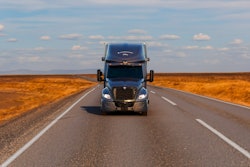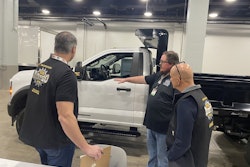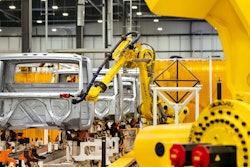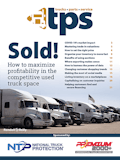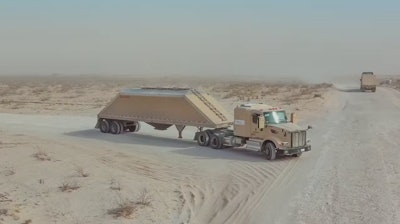
Autonomous trucks are an opportunity for suppliers, distributors, dealers and repair shops, ACT Research says. And it’s not a conversation for the future. Autonomous trucks are here, running routes now, albeit on a limited basis the experts say will grow slowly over the coming years.
The company recently held an informational session on the technology recently, featuring ACT team members Lydia Vieth and Ann Rundle discussing their research as well as a panel of experts including Dan Goff of Kodiak, Paul Konasewich from Paccar, and Josh Hankins with JB Hunt.
“This is a technology that’s real and here and it makes a difference in how people look at it,” Goff says. His company has a fleet of 10 driverless trucks delivering freight in the oilfields of west Texas.
State of autonomous trucking
Konasewich says OEMs aren’t far behind companies like Kodiak. At least three of the four major OEMs are in the late stages of development for their own autonomous platforms.
“In 2020, this was more of an idea,” he says. “Now it’s more of a soon-to-be completed R&D project.”
[RELATED: R&D expert preps aftermarket on future product innovations]
The OEMs serve as a quarterback for industry suppliers, Konasewich says. All of the companies have had to work together — “it’s a ton of work” — and those companies should get their due. Goff says autonomy only works as an ecosystem, and Tier 1 suppliers are a critical part of the system.
Goff says there are three pillars to deploying autonomous trucks. The first is technology. All the software components and hardware have to be ready to deploy and function reliably. Next comes safety, which is a different skillset and idea than technology. Lastly comes utility; the end product must be useful and bring value to OEMs, suppliers, carriers and customers.
“We’ve got to define what the value proposition is,” Hankins says. He points to inventory and holding costs as an opportunity. With autonomous trucking, it’s not just cost per load or cost per mile, it’s the cost of goods flowing through the supply chain.
[RELATED: Will AVs be part of the Messy Middle?]
Goff says Kodiak found a route that relieved pain points for customers and also gave the company, quite literally, a sandbox for the company to test the trucks. The company has a partnership with Atlas Energy Solutions in west Texas. It’s a difficult route to find drivers for and there’s a lot of demand.
“We see a lot of weird stuff,” Goff says. “That helps us strengthen the system.”
Autonomous trucking and jobs
At JB Hunt, Hankins says autonomous trucks aren’t going affect the company’s need for drivers. Many drivers are getting ready to retire, and those drivers need to be replaced. As autonomous routes begin to come online in the coming years, Hankins says drivers will shift to last-mile, urban settings.
“Driverless is not humanless,” Goff says, adding it takes a lot of people to build, maintain and oversee a driverless fleet. The workforce, he says, shifts away from the cab and to people near the cab. “There’s a lot of people for whom that shift is appealing.”
He points to the rise of intermodal freight. Drivers initially thought it would cut jobs, but in the end, it made more.
“More efficient freight means more freight,” Goff says.
Rundle says parts and service providers also will need more personnel. Autonomous trucks — with no need to stop for driver breaks — will run longer routes, both in terms of mileage and in terms of hours. That means trucks will need service more frequently, and some driver jobs may move to the shop floor. She compares it to the invention of container system, where the industry saw fewer of one kind of job but more of another, balancing out.
“While [autonomous trucks] will displace a truck driver in the long-haul but increase them in last-mile, they will also increase employees in the maintenance system,” she says. “If anything, we’ll see an incremental increase in those types of skilled trades jobs to maintain the equipment and an uptick in the number of people doing it as it starts to transition.”
What this means for parts and service
Rundle says as autonomous trucks hit the road, carriers may have more of a reliance on third-party providers because there’s not a driver in the truck to handle some issues on the road. Shops and dealers could cash in on inspections and maintenance as these trucks move themselves around the country.
[RELATED: New legislation would create national AV trucking framework]
Another opportunity is in transfer hubs, Vieth says. People will need to be hired to run transfer hubs no matter how many services the hub offers. Maintenance personnel, security staff, service and parts employees will all be needed to support autonomous trucks.
“It’s not just dealers setting up their own maintenance,” she says. “You’re getting this entire network of transfer hubs that will have to be staffed in various capacities.”
Depending on where a dealer is located, they could cash in on the opportunity by expanding their dealerships into transfer hubs, offering maintenance and inspection services. Partnering with AV suppliers could bring more opportunities for dealers and shops willing to make remote service calls and develop contracts with fleets depending on geographic region.
Another group that could cash in is the owner-operator, Rundle says. She references a recently ride-along in a Level 4 autonomous truck she experienced where the safety driver was an owner-operator. He had four tractors and would run one himself and hire drivers for the other three. He spent the extra money for an autonomous system because it worked better than a human driver.
“It’s not an instant payback,” Rundle warns, but eventually, “you could be an owner-operator and sitting on the beach and your truck is earning the money for you.”
What autonomous trucking means in the secondary market
A used autonomous truck is still a used truck, Rundle says. Manufacturers aren’t to the point yet where autonomous trucks won’t have a cab fit for a human driver, she says. In its second act, it could run as an autonomous truck, perhaps with a safety driver depending on the technology, or as a regular diesel truck.
That kind of shift is familiar in the industry, she says. A long-haul truck could move to a regional haul or drayage truck.
What Rundle does see is autonomous trucks entering the used market with slightly more miles than conventional trucks, but in a shorter time frame. The first owners may hold on to them a little longer, she says, but as of now, it’s all educated guesses. No one has flipped an autonomous truck. Even most of the ones on the road today are still owned by AV suppliers.
“It’s going to be a while before we see some huge, big flood of secondary-life autonomous vehicles,” she says.




